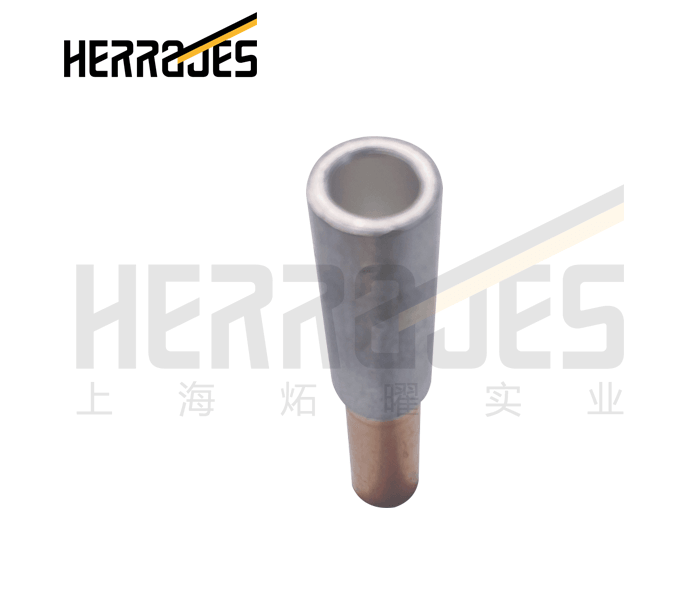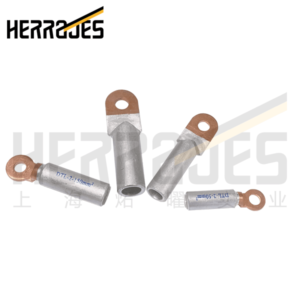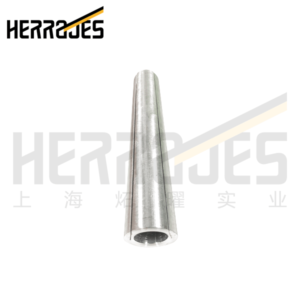Description
Technical Parameters and Drawings

| HE Code | L | A | B | d | D |
| HEGT-16 | 70 | 9 | 10 | 5.7 | 6.5 |
| HEGT-25 | 75 | 10 | 12 | 6.5 | 7.5 |
| HEGT-35 | 84 | 11 | 14 | 7.5 | 8.5 |
| HEGT-50 | 89.5 | 12 | 16 | 8.5 | 10.2 |
| HEGT-70 | 98.5 | 14 | 18 | 10 | 11.5 |
| HEGT-95 | 106 | 16 | 21 | 11.5 | 13.5 |
| HEGT-120 | 109 | 18 | 23 | 13.5 | 15 |
| HEGT-150 | 116 | 20 | 25 | 15 | 16.5 |
| HEGT-185 | 125 | 22 | 27 | 16.5 | 18.5 |
| HEGT-240 | 130 | 24 | 30 | 18.5 | 21 |
| HEGT-300 | 144 | 27 | 34 | 21 | 23.5 |
| HEGT-400 | 155 | 30 | 38 | 23.5 | 26.5 |
Notes:
| 1. Tolerance: ±5% | |
| 2. All dimensions are in MM except for marked. | |
| 3. Customized sizes are available at request.
|
Product Description:
The HEGT series copper connecting pipes are made from T2 copper, with reliable quality. They are mainly used for the connection between various round power cables in power distribution devices. The specifications and models are complete, and the surface has pickling and tin plating treatments
Why do we need to use Aluminum-copper connector?
The gray-white substance generated at the connection between the copper wire and the aluminum wire is aluminum oxide for a long time, and the contact resistance at the connection will increase and generate heat, which will easily cause a building fire when the circuit is on and off. So use a special copper-aluminum transition clip. Avoid unnecessary troubles! Copper-aluminum wire connection device (commonly known as “copper-aluminum nose”)
If the copper wire and the aluminum wire are directly hinged together, the joint is easily oxidized, resulting in an increase in resistance, which makes it easier to burn out. The real reason for this damage is that the aluminum element is more active than the copper element, and there will be many micro-potentials (that is, micro-batteries) on the copper-aluminum junction surface, resulting in micro-electrocorrosion, and the contact resistance will increase over time. For ordinary homework, it is more reliable to tin the copper first and then connect.
In the power system, copper and aluminum are directly connected, and galvanic corrosion will occur when current flows. Therefore, copper-aluminum transition should be used, or a tin sheet should be placed in the middle of the contact surface, and a layer of conductive paste should be applied if possible. When connecting ordinary households, the copper wire can be tinned and then connected to the aluminum wire to avoid galvanic corrosion.
Product Details:
Name: Bimetal sleeves, compression joints, compression repair sleeves, hydraulic overlap joints,
splicing tubes, mid span joints, Bimetal splicing sleeve for ASCR conductor, adapter bushing
HS code: 853890
Model:
Package: bulk packing; palletized; as required
Trademark: HE, as required
Origin: China
Raw material: aluminum and copper
Finish: tin plated
ODM&OEM service: yes
Sample: available, FOC
Payment term: T/T, 30% prepayment and 70% balance against B/L
Certificate: ISO
Delivery time: 20-40 days
MOQ: 500pcs
Export term: FOB; CIF
Production capacity pcs/day: 2000











